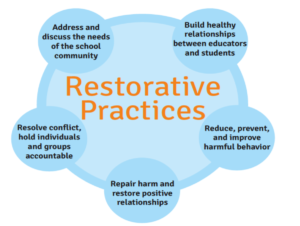Positive relationships in education are key to effective teaching and learning, and health and mental wellbeing (M. Thorsborne). Restorative approaches in education settings are based upon the principles of Restorative Justice in the criminal justice system – and are grounded in repairing and resorting relationships when they have been harmed. It moves away from the language and culture of blame towards an ethos of relational problem solving for the repair of harm. It is a philosophy, not a model, and ought to guide the way we act in our dealings with others (B. Hopkins).
Like Building on Positive Relationships, for  Restorative Approaches to be successfully implemented, it is crucial that they are preceded by a positive relationship between the adult and child or young person. One of the important characteristics involved in Restorative Approaches, is the display of curiosity around the young people and around the situation. The adult must explore the feelings and thoughts of both the one who was harmed, as well as the one who caused the harm. The quality of curiosity will enable the young person to feel understood instead of judged. It will also allow the person being harmed to express how the harm has affected them. Moreover, it will allow the person who caused the harm to explain what they were thinking at the time, and to witness how their actions have impacted the other person.
Restorative Approaches to be successfully implemented, it is crucial that they are preceded by a positive relationship between the adult and child or young person. One of the important characteristics involved in Restorative Approaches, is the display of curiosity around the young people and around the situation. The adult must explore the feelings and thoughts of both the one who was harmed, as well as the one who caused the harm. The quality of curiosity will enable the young person to feel understood instead of judged. It will also allow the person being harmed to express how the harm has affected them. Moreover, it will allow the person who caused the harm to explain what they were thinking at the time, and to witness how their actions have impacted the other person.
A restorative conversation may not always involve the person harmed and the person who caused the harm to meet at the same time. However, it allows both these people to be heard. Under the appropriate circumstances, this will oftentimes lead to the person who caused the harm to show remorse for the harm they have caused. This may or may not be followed by a natural consequence to what they did. However, that natural consequence will always be in proportion to the harm caused, and will not be intended as a punishment (natural consequence vs punishment)! Whereas a punishment often leaves the one who caused harm feeling shameful and perhaps resentful – a restorative approach allows them to learn about the impact of their behaviours, and teaches them accountability.
The distinctions between shame and guilt, are massive. When experienced during appropriate times with proportionate amounts, guilt can motivate one to take accountability for their actions, and acknowledge the harm caused. Therefore it can support that person in repairing a situation. Experiencing shame, on the other hand, can have extremely adverse effects. Shame tends to target the individual rather than the action, and can leave the young person feeling shameful for their identity, and who they are. This often leads to lowered self-esteem, withdrawal, and even escalation of the behaviour. It is vital that during Restorative Approaches, young people are not shamed for their behaviour!
For further information please see below:
- The following research article co-authored by one of our Educational Psychologists, is available to download – What impact has the Educational Psychology Service had on the implementation of restorative approaches activities within schools across a Scottish Local Authority? Taryn Moir and Sue MacLeod – Download this paper (pdf, 183Kb)
- You can download a parent leaflet
- We have developed Guidance for the Delivery of a Restorative Approach in Schools (pdf, 8Mb) based on Guidance developed by the Scottish Government (October 2017).

